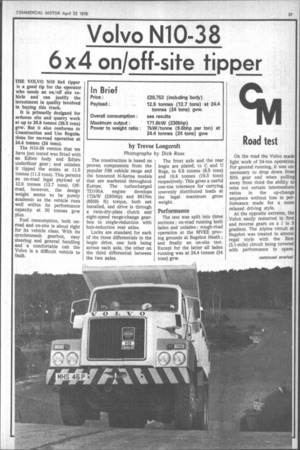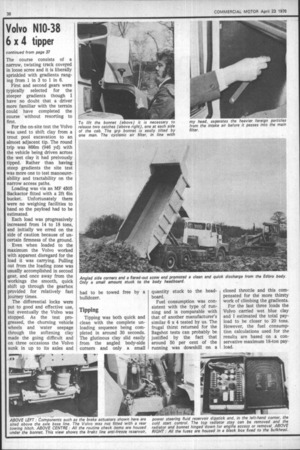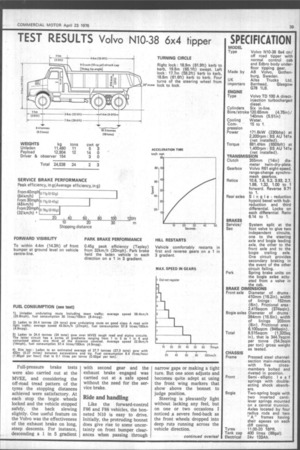cm
Page 39

Page 40

Page 41

Page 42

If you've noticed an error in this article please click here to report it so we can fix it.
Road test
On the road the Volvo made light work of 24-ton operation. For general running, it was unnecessary to drop down from fifth gear and when pulling away from third the ability to miss out certain intermediate ratios in the up-change sequence without loss in performance made for a more relaxed driving style.
At the opposite extreme, the Volvo easily restarted in first and reverse gears on a 1 in 3 gradient. The Alpine circuit at Bagshot was treated in almost regal style with the 5km (3.1-mile) circuit being covered with performance to spare. The course consists of a narrow, twisting track cove,red in loose scree and it is liberally sprinkled with gradients ranging from 1 in 3 to 1 in 6.
First and second gears were typically selected for the steeper gradients though I have no doubt that a driver more familiar with the terrain could have completed the course without resorting to first.
For the on-site test the Volvo was used to shift clay from a trout pool excavation to an almost adjacent tip. The round trip was 866m (946 yd) with the vehicle being driven across the wet clay it had preivously tipped. Rather than having steep gradients the site test was more one to test manoeuvrability and tractability on the narrow access paths.
Loading was via an MF 4505 Backactor fitted with a 2ft 6in bucket, Unfortunately there were no weighing facilities to hand so the payload had to be estimated.
Each load was progressively increased from 14 to 18 tons, and initially we erred on the side of caution because of uncertain firmness of the ground.
Even when loaded to the maximum the Volvo worked with apparent disregard for the load it was carrying. Pulling out from the loading zone was usually accomplished in second gear, and once away from the workings the smooth, quick shift up through the gearbox provided for relatively fast journey times.
The differential locks were put to good and effective use, but eventually the Volvo was stopped. As the test progressed, the churning vehicle wheels and water seepage through the softening clay made the going difficult and on three occasions the Volvo sunk in up to its axles and 110.1.,1 -7 ' had to be towed free by a bulldozer.
Tipping
Tipping was both quick and clean with the complete unloading sequence being completed in around 30 seconds. The glutinous clay slid easily from the angled body-side corners and only a small quantity stuck to the headboard.
Fuel consumption was consistent with the type of running and is comparable with that of another manufacturer's similar 6 x 4 tested by us. The frugal thirst returned for the Bagshot tests can probably he justified by the fact that around 50 per cent of the running was downhill on a closed throttle and this compensated for the more thirsty work of climbing the gradients.
For the last three loads the Volvo carried wet blue clay and I estimated the total payload to be closer to 20 tons. However, the fuel consumption calculations used for the results are based on a conservative maximum 18-ton payload.
Full-pressure brake tests were also carried out at the MVEE, and considering the off-road tread pattern of the tyres the stopping distances achieved were satisfactory. At each stop the bogie wheels locked and the vehicle stopped safely, the back slewing slightly. One useful feature on the Volvo was the effectiveness of the exhaust brake on long, steep descents. For instance, descending a 1 in 5 gradient with second gear and the exhaust brake engaged was carried out at a safe speed without the need for the service brake.
Ride and handling
Like the forward-control F86 and F88 vehicles, the bonneted NIO is easy to drive. Initially, the protruding bonnet does give rise to some uncertainty on front bumper clearances when passing through narrow gaps or making a tight turn. But one soon adjusts and becomes quite adept at using the front wing markers that show above the bonnet to judge position.
Steering is pleasantly light without lacking any feel, but on one or two occasions I noticed a severe feed-back as the front wheels dropped into deep ruts running across the vehicle direction. The ride both on the road and on site was surprisingly smooth and vibration free. When moving across site at reasonable speeds the driver is not jostled; any excessive movement is taken up by the suspension seat.
Controls and gauges
The cab furniture carries the usual Volvo stamp with all the controls and gauges being con veniently placed. One minor criticism is the position of the driver's side quarter-light catch when the window is open. When working the steering wheel it is easy to snag your fingers on it and get a nasty bruise.
The in-cab direction indicator warning-lights are not suf ficiently bright to show clearly in daylight. Consequently, it is possible inadvertently to for get to cancel the indicators once a manoeuvre is completed.
A rubber mat spreads across the cab floor and the trim is functionally designed for easy cleaning down. The cab is quiet, making the fitting of a radio worth while.
The vehicle is easy to drive and the cab as comfortable as those of most 32-tonners, and if the Volvo reputation for reliability is anything to go by the MO 6 x 4 tipper will be a useful tool. However, at £20,753 the Volvo will have to be worked hard to get a good return on the investment.
































































































